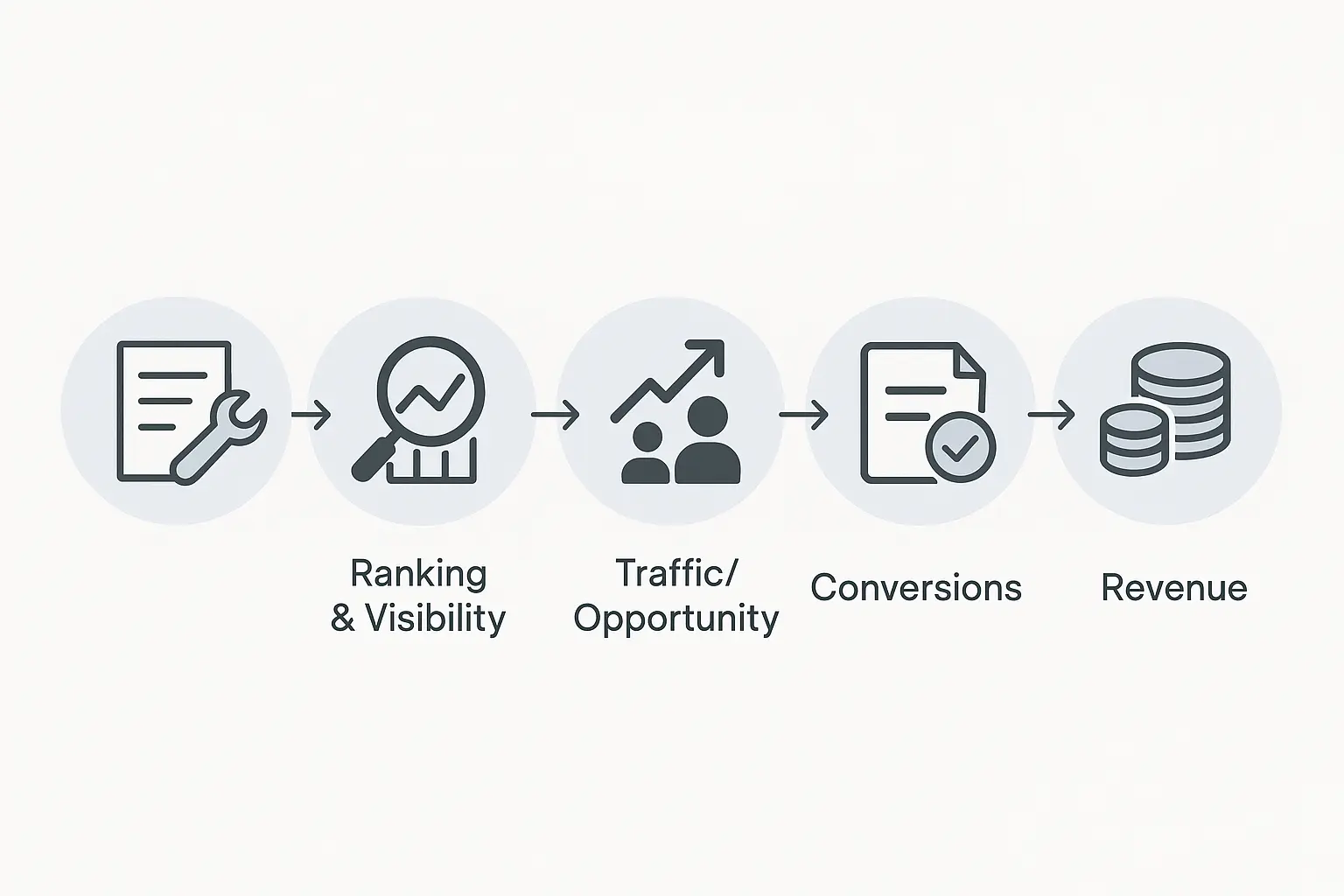You’ve been there before. The quarterly review with your client’s leadership team is on the calendar. You have your dashboard ready, filled with upward-trending graphs: organic traffic is up 30%, keyword rankings for top terms are in the top three, and your domain authority has climbed five points.
You’re proud of the work, but as you prepare, a sense of dread creeps in. You’re not presenting to the marketing manager this time; you’re presenting to the CEO and CFO. Will they care about bounce rate? Does “time on page” mean anything to them?
If this feels familiar, you’re not alone. There’s a fundamental disconnect in how we often report on SEO. While we see progress, C-suite executives see costs. Sobering research from the Marketing Accountability Standards Board reveals that 73% of executives believe marketing doesn’t generate enough revenue. They aren’t speaking our language, and it’s our job to become fluent in theirs.
This guide offers a new framework—and a simple template—for shifting the conversation from metrics to money. It’s about telling a compelling story of business growth, with SEO as the hero.
The Language Gap: Why Your SEO Reports Are Falling Flat
The problem isn’t your SEO strategy; it’s your communication strategy. We deliver reports filled with practitioner-level metrics because that’s how we measure our own work.
We say: “We increased organic traffic by 30%.”They hear: “More people visited the website, but did they buy anything?”
We say: “We are now ranking #1 for ‘blue widgets’.”They hear: “So what? Did our top competitor sell more blue widgets than us last quarter?”
This isn’t because executives are dismissive. It’s because they operate on a different set of KPIs: Customer Acquisition Cost (CAC), Lifetime Value (LTV), market share, and, most importantly, revenue. A staggering 82% of executives want to see a clear and quantifiable ROI from marketing. If your report doesn’t connect your activities to these outcomes, it’s just noise.
The goal is to stop reporting on SEO activities and start communicating business impact.
From Metrics to Narrative: A 4-Part Template for C-Suite Reporting
To bridge this language gap, you need a new reporting structure. Instead of a data dump, think of your report as a concise business briefing that tells a clear story in under five minutes.
Here is a simple, four-part framework for your next C-suite SEO report.
Part 1: The Executive Summary (The 30-Second Story)
Start with the conclusion. C-suite leaders are time-poor and need the bottom line upfront. This section should be a single, powerful paragraph that summarizes the business outcome of your SEO efforts.
What to include:
- The primary business win: Lead with the most impressive revenue-focused achievement.
- A key supporting metric: Briefly mention the core activity that drove this result.
- The ROI: State the return on investment in clear financial terms.
Example Narrative:
“This quarter, our strategic SEO focus on high-intent search terms generated an estimated $150,000 in new sales pipeline, a 25% increase from Q1. This growth was driven by capturing the #1 position for ‘enterprise-grade blue widgets,’ resulting in a 7x return on our SEO investment for the quarter.”
This approach immediately answers the “So what?” question and frames the entire conversation around business growth.
Part 2: Performance Against Business Goals (Connecting SEO to Strategy)
Now you can provide more context, but keep it strategic. This section should link your SEO performance directly to the company’s overarching business objectives. Are they trying to enter a new market, launch a new product, or steal market share?
Remember, 69% of executives say marketing needs to be a key driver of business strategy. This is your chance to prove that SEO isn’t just a marketing channel—it’s a strategic growth lever.
How to frame it:
- Instead of “Keyword Rankings,” use “Market Share Visibility.” Show a chart of your share of voice for critical, non-branded keywords versus your top two competitors.
- Instead of “Organic Traffic,” use “Qualified Lead Generation.” Report on the number of marketing-qualified leads (MQLs) or demo requests that came from organic search.
- Instead of “Backlinks,” use “Brand Authority & PR Impact.” Frame links from high-authority sites as digital PR placements that enhance brand credibility and trust.

Part 3: Revenue Impact & Financial ROI (The Most Important Slide)
This is where you make the undeniable case for SEO. For many, this is the hardest part due to tracking limitations. But you don’t need perfect attribution to tell a powerful story; you just need a credible model.
A Simple Revenue Impact Formula:
(Total Organic Traffic to Key Pages) x (Conversion Rate of Those Pages) x (Average Lead Value or Customer Lifetime Value) = Estimated SEO-Driven Revenue
Even if you can only track leads, assigning a value to them creates a tangible financial metric. This approach is critical. Companies that successfully align their sales and marketing efforts by speaking the same language of revenue generate 209% more revenue from marketing.
This section should visually represent the connection between your work and the company’s bottom line. A simple bar chart showing SEO investment versus SEO-driven revenue can be incredibly effective.

Part 4: Competitive Intelligence & Future Opportunities
Finally, use your SEO data to offer strategic insights that go beyond your own website. Search data is a treasure trove of market intelligence.
What to include:
- Threats: “Our main competitor just launched a new content hub targeting a customer segment we haven’t explored. Their visibility for these terms is up 50%.”
- Opportunities: “We’ve identified a rising trend in searches for ‘sustainable blue widgets,’ a keyword set with low competition. This represents an untapped market we can capture in Q3.”
- Strategic Recommendations: “Based on this data, we recommend allocating next quarter’s content resources to building a ‘Sustainable Widget’ resource center. This will establish us as the market leader before competitors can act.”
This positions you as a strategic partner, not just a vendor. You’re offering proactive, data-driven counsel that can shape business strategy. That’s invaluable, especially when you consider that 55% of CMOs are under intense pressure to prove their marketing ROI. Helping your client look good and act strategically builds immense trust.

The Power of Automation in Strategic Communication
Crafting a compelling narrative takes time—time you don’t have if you’re buried in manual data pulls and spreadsheet formulas. This is where technology becomes a competitive advantage. Using automated SEO reporting tools can handle the data aggregation, freeing your team to focus on analysis, strategy, and telling the revenue story that executives need to hear.
Frequently Asked Questions
What if we can’t track revenue directly from SEO?
This is a common challenge, so use proxy metrics. Work with the client’s sales team to determine an “average lead value.” If only one in ten leads from your contact form becomes a customer worth $10,000, then each lead is worth $1,000 to the pipeline. Use that to calculate your estimated revenue impact.
How often should I send a report like this?
A detailed C-suite report is most effective quarterly. This timing aligns with business planning cycles and allows enough time for SEO efforts to show meaningful results. For your day-to-day marketing contact, monthly reports with more granular metrics are still appropriate.
What’s the biggest mistake to avoid when presenting to executives?
Leading with jargon. The moment you start talking about algorithm updates, canonical tags, or schema markup, you’ve lost them. Frame everything in the language of business: risk, opportunity, market share, and revenue.
How do I report on a bad quarter?
Transparency is key. Don’t hide the data; lead with the insights. Explain why performance dipped (e.g., a competitor’s aggressive campaign, a seasonal trend) and present a clear, data-backed plan to address the issue in the coming quarter. Turning a challenge into a strategic plan demonstrates proactivity and builds trust.
Your New Role: From SEO Manager to Business Strategist
Shifting your reporting from a dashboard of metrics to a narrative of growth fundamentally changes your relationship with your clients. You’re no longer just an agency executing tasks; you become an indispensable strategic partner.
By speaking the language of the C-suite, you not only prove your value but also secure bigger budgets, earn more trust, and embed SEO into the very core of your client’s business strategy. For agencies that need support delivering these kinds of growth-focused results at scale, the right white-label SEO partner can provide the engine to make it all happen.
Stop reporting on what you did. Start communicating the business value you created.

